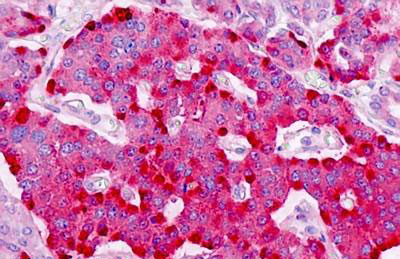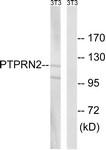PTPRN2 / Phogrin Antibody (aa206-255)
Rabbit Polyclonal Antibody
- SPECIFICATION
- CITATIONS
- PROTOCOLS
- BACKGROUND

Application
| WB, IHC-P, E |
|---|---|
| Primary Accession | Q92932 |
| Other Accession | 5799 |
| Reactivity | Human, Mouse, Rat |
| Host | Rabbit |
| Clonality | Polyclonal |
| Isotype | IgG |
| Calculated MW | 111271 Da |
| Dilution | ELISA (1:10000), IHC-P (10 µg/ml), WB (1:500 - 1:1000), |
| Gene ID | 5799 |
|---|---|
| Other Names | PTPRN2, ICAAR, Ia-2 beta, IA-2beta, PTPRP, R-PTP-N2, Phogrin, Ptp-np, IAR, KIAA0387, PTP NE-6, Tyrosine phosphatase IA-2 beta |
| Target/Specificity | PTPRN2 Antibody detects endogenous levels of total PTPRN2 protein. |
| Reconstitution & Storage | PBS (without Mg2+, Ca2+), pH 7.4, 150 mM sodium chloride, 0.02% sodium azide, 50% glycerol. Store at -20°C for up to one year. |
| Precautions | PTPRN2 / Phogrin Antibody (aa206-255) is for research use only and not for use in diagnostic or therapeutic procedures. |
| Name | PTPRN2 |
|---|---|
| Synonyms | KIAA0387 |
| Function | Plays a role in vesicle-mediated secretory processes. Required for normal accumulation of secretory vesicles in hippocampus, pituitary and pancreatic islets. Required for the accumulation of normal levels of insulin-containing vesicles and preventing their degradation. Plays a role in insulin secretion in response to glucose stimuli. Required for normal accumulation of the neurotransmitters norepinephrine, dopamine and serotonin in the brain. In females, but not in males, required for normal accumulation and secretion of pituitary hormones, such as luteinizing hormone (LH) and follicle- stimulating hormone (FSH) (By similarity). Required to maintain normal levels of renin expression and renin release (By similarity). May regulate catalytic active protein-tyrosine phosphatases such as PTPRA through dimerization (By similarity). Has phosphatidylinositol phosphatase activity; the PIPase activity is involved in its ability to regulate insulin secretion. Can dephosphorylate phosphatidylinositol 4,5-biphosphate (PI(4,5)P2), phosphatidylinositol 5-phosphate and phosphatidylinositol 3-phosphate (By similarity). Regulates PI(4,5)P2 level in the plasma membrane and localization of cofilin at the plasma membrane and thus is indirectly involved in regulation of actin dynamics related to cell migration and metastasis; upon hydrolysis of PI(4,5)P2 cofilin is released from the plasma membrane and acts in the cytoplasm in severing F-actin filaments (PubMed:26620550). |
| Cellular Location | Cytoplasmic vesicle, secretory vesicle membrane {ECO:0000250|UniProtKB:P80560}; Single-pass type I membrane protein {ECO:0000250|UniProtKB:P80560}. Cytoplasmic vesicle, secretory vesicle, synaptic vesicle membrane {ECO:0000250|UniProtKB:P80560}; Single-pass type I membrane protein {ECO:0000250|UniProtKB:P80560} Note=Predominantly found on dense-core secretory granules. Sorting to secretory granules in part is dependent of the N-terminal propeptide domain of the precursor and its interaction with CPE (By similarity) Transiently found at the cell membrane, when secretory vesicles fuse with the cell membrane to release their cargo. Is then endocytosed and recycled to secretory vesicles involving clathrin-dependent AP2- mediated endocytosis. Recycled via STX6- but not TTTGN1/TGN38- containing compartments (By similarity). {ECO:0000250|UniProtKB:P80560, ECO:0000250|UniProtKB:Q63475} |
| Tissue Location | Highest levels in brain and pancreas (PubMed:8798755, PubMed:8954911). Lower levels in trachea, prostate, stomach and spinal cord (PubMed:8798755). |
| Volume | 50 µl |

Thousands of laboratories across the world have published research that depended on the performance of antibodies from Abcepta to advance their research. Check out links to articles that cite our products in major peer-reviewed journals, organized by research category.
info@abcepta.com, and receive a free "I Love Antibodies" mug.
Provided below are standard protocols that you may find useful for product applications.
Background
Implicated in development of nervous system and pancreatic endocrine cells.
References
Kawasaki E.,et al.Biochem. Biophys. Res. Commun. 227:440-447(1996).
Smith P.D.,et al.Biochem. Biophys. Res. Commun. 229:402-411(1996).
Cui L.,et al.J. Biol. Chem. 271:24817-24823(1996).
Jiang S.,et al.Submitted (DEC-1996) to the EMBL/GenBank/DDBJ databases.
Nagase T.,et al.DNA Res. 4:141-150(1997).
If you have used an Abcepta product and would like to share how it has performed, please click on the "Submit Review" button and provide the requested information. Our staff will examine and post your review and contact you if needed.
If you have any additional inquiries please email technical services at tech@abcepta.com.













 Foundational characteristics of cancer include proliferation, angiogenesis, migration, evasion of apoptosis, and cellular immortality. Find key markers for these cellular processes and antibodies to detect them.
Foundational characteristics of cancer include proliferation, angiogenesis, migration, evasion of apoptosis, and cellular immortality. Find key markers for these cellular processes and antibodies to detect them. The SUMOplot™ Analysis Program predicts and scores sumoylation sites in your protein. SUMOylation is a post-translational modification involved in various cellular processes, such as nuclear-cytosolic transport, transcriptional regulation, apoptosis, protein stability, response to stress, and progression through the cell cycle.
The SUMOplot™ Analysis Program predicts and scores sumoylation sites in your protein. SUMOylation is a post-translational modification involved in various cellular processes, such as nuclear-cytosolic transport, transcriptional regulation, apoptosis, protein stability, response to stress, and progression through the cell cycle. The Autophagy Receptor Motif Plotter predicts and scores autophagy receptor binding sites in your protein. Identifying proteins connected to this pathway is critical to understanding the role of autophagy in physiological as well as pathological processes such as development, differentiation, neurodegenerative diseases, stress, infection, and cancer.
The Autophagy Receptor Motif Plotter predicts and scores autophagy receptor binding sites in your protein. Identifying proteins connected to this pathway is critical to understanding the role of autophagy in physiological as well as pathological processes such as development, differentiation, neurodegenerative diseases, stress, infection, and cancer.



